Thursday 21 December, 2006, 15:58 - Pirate/Clandestine
 Was doing a bit of 'Googling', as you do, and came across an attempt by Anthony Page (of Radio Nemesis fame), to start a pirate radio Wiki.
Was doing a bit of 'Googling', as you do, and came across an attempt by Anthony Page (of Radio Nemesis fame), to start a pirate radio Wiki.The page at freeradio.wiki-site.com mostly recounts the history of many of the pirate radio stations who graced the airwaves in the South Yorkshire and Derbyshire areas in the 1980's and 1990's; but it's also not a bad attempt to try and define some of the terms such as 'stereo' and 'link' so it get's an 'A' for effort, though at present probably no more than about a 'C' for achievement. With help from people such as you (yes, you) then maybe it could get a lot better.
There's also a good description of a number of the pirate stations that used to broadcast in that area including:
* Rebel Radio 105.2 (with Scooter Jones)
* Ocean FM 106.3 from Rotherham (which is nowhere near the sea!)
* WLNG 104.9 of Scunthorpe (who get a mention here)
* Radio Britannia from Barnsley with DJ Ken(ny) Crescendo
And no listing would be complete without the infamous ZFM 102.4/105.2/105.5 (mentioned here amongst other places) of Sheffield whose jingles, if I remember rightly, included the classics: 'ZFM - no flies on them' and 'ZFM - it rhymes with phlegm'. Isn't it reassuring to know that radio presentation has moved on...!
4 comments
( 2538 views )
| permalink
| 



 ( 2.9 / 17412 )
( 2.9 / 17412 )




 ( 2.9 / 17412 )
( 2.9 / 17412 )
Thursday 9 March, 2006, 15:24 - Pirate/Clandestine
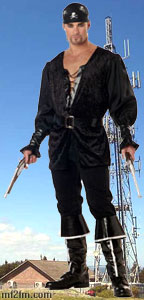 With all this talk of pirate radio, a question that often gets asked is, "But I've never heard a pirate station; where do I find one?". Yes, there are those who have yet to stumble across the skull and crossbones of the airwaves!
With all this talk of pirate radio, a question that often gets asked is, "But I've never heard a pirate station; where do I find one?". Yes, there are those who have yet to stumble across the skull and crossbones of the airwaves!The best place to look is on the FM dial of your radio. But with so many stations around, how do you know if the station you are listening to is a pirate or a legal station? There are a few clues which even the least experience listener should be able to fathom:
1. The signal is in mono. Most pirate stations broadcast in mono, however, this is not at all conclusive as many RSL stations do this too and further, some pirates broadcast in stereo.
2. There is no RDS. Including RDS can be complicated for some pirates so they choose not to use it. This is still not totally conculsive though, as some RSL stations have no RDS either.
 3. The RDS is 'scrolling' (i.e. it is changing to display a message - as shown here on the right). Legal stations in Europe are obliged by the European Commission to use a static name on their RDS display to make sure drivers aren't distracted. Pirates, however, can change the name of the station to display messages on RDS equipped radios. A few legal stations (not in the UK though) do scroll or rotate the message on the RDS display so this too isn't totally conclusive, however reading the message might give a good indication. If it's advertising a party at a local night club then chances are you're listening to a local pirate!
3. The RDS is 'scrolling' (i.e. it is changing to display a message - as shown here on the right). Legal stations in Europe are obliged by the European Commission to use a static name on their RDS display to make sure drivers aren't distracted. Pirates, however, can change the name of the station to display messages on RDS equipped radios. A few legal stations (not in the UK though) do scroll or rotate the message on the RDS display so this too isn't totally conclusive, however reading the message might give a good indication. If it's advertising a party at a local night club then chances are you're listening to a local pirate!4. The presenter doesn't have a middle-class accent! This is especially true on FM stations in the UK, where legal stations try to recruit presenters with unoffensive voices that won't turn listeners off. As pirate stations are usually there to promote the music or club nights, whether the presenter can pronounce 'Douglas St.John Farquhar' correctly really doesn't matter!
 5. The phone number being given out to contact the station is a mobile number (all mobile numbers begin with '07' in the UK). How many legal stations do you know who would, or would need to, use a mobile number for calls to the studio? Further, if you're requested to leave 'missed calls', i.e. to phone the number but not let it answer, you're almost certainly onto a pirate. This is a way to show you are listening without having to spend a single penny on phone calls - quite smart really!
5. The phone number being given out to contact the station is a mobile number (all mobile numbers begin with '07' in the UK). How many legal stations do you know who would, or would need to, use a mobile number for calls to the studio? Further, if you're requested to leave 'missed calls', i.e. to phone the number but not let it answer, you're almost certainly onto a pirate. This is a way to show you are listening without having to spend a single penny on phone calls - quite smart really!Of course there are other clues, such as the frequency being used (if it's in the middle of the band used for national BBC stations but isn't a BBC station then it's most likely a pirate), but the ones above don't require any technical knowledge. You're more likely to find a pirate station on FM if you live in, or near, a major city than if you live out in the countryside, but you might be surprised.
Another place to find pirates is in the radio no man's land just at the edges of the normal short-wave broadcast bands, especially the lower frequency bands. Why the lower frequency bands in particular - they're better for broadcasting to nearby areas and tend to be more reliable throughout the daily propagation cycle. Good places to listen for pirate short-wave stations are:
* 3800-3950 and 4000-4100 kHz, either side of the 75m broadcast band
* 5750-5900 and 6200-6400 kHz, either side of the 49m broadcast band
* 6800-7000 and 7350-7600 kHz, either side of the 41m broadcast band (avoiding the 40m amateur band too)
* 9300-9400 and 9900-10000 kHz, either side of the 31m broadcast band
And so on either side of the other short wave broadcast bands too... Though the use of frequencies above about 10 MHz is rarer, there are examples such as Alfa Lima on 15070 (± a bit) and 21900 (± a bit) kHz and WR International on 12256 kHz.
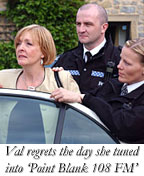 One final place you might come across a pirate station is on the medium wave (MW) band. Most stations prefer FM for local broadcasting as the antennas are smaller and the equipment easier to get hold of, but a few stations do use MW. Radio Free London used to put out a good signal across London on 819 kHz and there are quite a few stations (particularly in continental Europe) who inhabit the no man's land just off the end of the MW band between 1611 and 1640 kHz.
One final place you might come across a pirate station is on the medium wave (MW) band. Most stations prefer FM for local broadcasting as the antennas are smaller and the equipment easier to get hold of, but a few stations do use MW. Radio Free London used to put out a good signal across London on 819 kHz and there are quite a few stations (particularly in continental Europe) who inhabit the no man's land just off the end of the MW band between 1611 and 1640 kHz.Of course I couldn't possibly condone any activity which would lead you to listen to a pirate and thus break the law in doing so. But at least now you might be able to stop yourself from committing this heinous crime before you get caught!
Thursday 1 December, 2005, 09:38 - Pirate/Clandestine
Towards the beginning of November this year, Ofcom conducted a massive series of raids on pirate radio stations in London, and event considered news-worthy even by the BBC.The operation closed 53 pirate FM stations in London and whilst some of the bigger stations are now back on-air, for some stations, losing a transmitter may mark the end of their broadcasts for some time. One station (On Top FM) also had a studio raid which can be devastating, and is certainly much more difficult to recover from.
What is interesting about this surge of activity by Ofcom is not that it was long overdue, or that it was so widespread, but was some of the 'anti-pirate' propaganda that Ofcom, a supposedly respectable body, spouted in their press release.
"Illegal broadcasting causes interference to the radios used by critical safety of life services such as the London Fire Brigade and National Air Traffic Services (NATS)."
 Let's examine this statement. The London Fire Brigade uses frequencies of 70.5 - 71.5 MHz paired with 80.0 - 82.5 MHz, 148.825 MHz (for pagers), various frequencies between 450 and 453 MHz paired with 464.9 - 467.9 and 457 - 457.5 paired with 462.5 - 463 MHz. Now unless I am mistaken, none of these frequencies are directly affected by transmissions in the FM band (87.5 - 108 MHz) otherwise they would receive interference every day from the legal stations. Indeed other than for the fourth harmonics of transmitters on 90-90.6, 93-93.5 (actually BBC Radio 4 in London), 91.4-91.5 and 92.5-92.6 MHz, it's difficult to see where their problem arises. So if the Fire Service are suffering interference from pirate transmissions it is probably from one of two sources:
Let's examine this statement. The London Fire Brigade uses frequencies of 70.5 - 71.5 MHz paired with 80.0 - 82.5 MHz, 148.825 MHz (for pagers), various frequencies between 450 and 453 MHz paired with 464.9 - 467.9 and 457 - 457.5 paired with 462.5 - 463 MHz. Now unless I am mistaken, none of these frequencies are directly affected by transmissions in the FM band (87.5 - 108 MHz) otherwise they would receive interference every day from the legal stations. Indeed other than for the fourth harmonics of transmitters on 90-90.6, 93-93.5 (actually BBC Radio 4 in London), 91.4-91.5 and 92.5-92.6 MHz, it's difficult to see where their problem arises. So if the Fire Service are suffering interference from pirate transmissions it is probably from one of two sources:(1) The FM transmitters used by the pirates are of such low quality that they emit spurious signals on lots of frequencies. This is certainly possible, especially given the low-cost nature of the transmitters that pirates use, however the chances are that any transmitters prone to spurious emissions will be tracked down immediately as they will be causing interference to potentially hundreds of users.
(2) It is not the FM transmitters that cause the problem but is, instead, the link transmitters which are used to connect the pirates' studios to the transmitter site. Such links normally operate either in Band I (47 - 68 MHz) or at microwave frequencies. Microwave links are hardly likely to cause interference but it is feasible that the Band I links might if their frequencies co-incided with those used by the Fire Service. However, I doubt that any pirate would use a frequency knowing that it might interfere with the emergency services, even though they are operating illegally, they are not stupid enough to intentionally cause interference and risk the wrath of Ofcom.
 There is one other possibility. The frequencies used by the Fire Service in the UK are used in some Eastern European countries for FM broadcasting! The 'OIRT' band covers 66 - 74 MHz and high-power transmitters still provide service in countries such as Russia, Moldova and Hungary. During certain propagation conditions, such stations are often heard in the UK (they do use high powers after all) and whilst I suspect that most firemen would know the difference between Russian and English, if they just hear music over their radio system they are going to assume it's a pirate.
There is one other possibility. The frequencies used by the Fire Service in the UK are used in some Eastern European countries for FM broadcasting! The 'OIRT' band covers 66 - 74 MHz and high-power transmitters still provide service in countries such as Russia, Moldova and Hungary. During certain propagation conditions, such stations are often heard in the UK (they do use high powers after all) and whilst I suspect that most firemen would know the difference between Russian and English, if they just hear music over their radio system they are going to assume it's a pirate.So do the pirates cause interference to the Fire Service or not? Well I have no reason to doubt John Anthony, London Fire Brigade Assistant Commissioner who claims that, "... radio transmissions interfere with, and sometimes entirely disable, the communications systems the London Fire Brigade relies on." But is it really pirates or could it be the Russians instead?
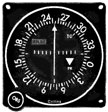 Next onto the Air Traffic Service. They use many frequencies but in particular use 108 - 137 MHz which is directly adjacent to the FM band. A report from 1997, 'Investigation of Interference Sources and Mechanisms...' showed that illegal transmitters were a constant source of interference to both navigation and communication. This is easier to understand as spurious emissions from a transmitter are usually close in frequency to the main transmission thus spurii in the band 108 - 137 MHz are not unlikely. Thus I don't necessarily doubt 'A spokesman for NATS' who said, "Unauthorised broadcasts on or close to frequencies used by air traffic controllers can interfere with the passing of vital information between air traffic controllers and pilots. They can also affect the navigation aids used as landmarks." Point to Ofcom!
Next onto the Air Traffic Service. They use many frequencies but in particular use 108 - 137 MHz which is directly adjacent to the FM band. A report from 1997, 'Investigation of Interference Sources and Mechanisms...' showed that illegal transmitters were a constant source of interference to both navigation and communication. This is easier to understand as spurious emissions from a transmitter are usually close in frequency to the main transmission thus spurii in the band 108 - 137 MHz are not unlikely. Thus I don't necessarily doubt 'A spokesman for NATS' who said, "Unauthorised broadcasts on or close to frequencies used by air traffic controllers can interfere with the passing of vital information between air traffic controllers and pilots. They can also affect the navigation aids used as landmarks." Point to Ofcom!"Illegal broadcasting also causes interference to legitimate radio stations, denying hundreds of thousands of listeners the opportunity to hear their favourite programmes."
Does it now? Well in some cases yes. Drive past a pirate transmitter and if you are tuned to a nearby frequency there is every likelihood that you will hear the pirate 'splattering' over the top of the station you were trying to listen to (though the same thing would also happen if you drove past a legal transmitter). However, some pirates operate 200 kHz or less away from legal stations which is insufficient to prevent such interference (legal stations typically leave a gap of 400 kHz to prevent these problems occuring). However legal stations typically use much more power than pirate stations and the effect is very localised (and anyway whose to say that your favourite programme isn't on a pirate station...)
 It is only in desperation, however, that pirates would choose a frequency likely to interfere with a legal station. In London such desparation stems from the lack of available frequencies (as most are already used by legal and other pirate stations). Given the option, most pirates choose a frequency as unlikely as possible to interfere with legal stations as it's much more likely that a complaint will be received against them if they do cause interference as if they don't.
It is only in desperation, however, that pirates would choose a frequency likely to interfere with a legal station. In London such desparation stems from the lack of available frequencies (as most are already used by legal and other pirate stations). Given the option, most pirates choose a frequency as unlikely as possible to interfere with legal stations as it's much more likely that a complaint will be received against them if they do cause interference as if they don't.Overall I suspect that pirate radio does cause interference in one or two cases, however in many cases it operates quite happily without causing problems to anyone else. Kudos to Ofcom for having a go at the problem, but only time will tell whether they will make any dent on the runaway train of stations that inhabit every nook and cranny of the FM band in London (and in some other major cities).
Of course there are other solutions, one being to actually licence the stations concerned and bring them into a controlled environment. Ofcom has already licensed about 30 community radio stations, however it claims that such services can only be licensed in remote areas where spare frequencies exist. A change in planning rules to recognise the low potential for interference that properly organised low-power FM stations cause might open up the band to more users and solve the pirate problem in a much more effective way.
Thursday 3 November, 2005, 10:36 - Pirate/Clandestine
Any illegal radio transmission runs the risk of being tracked down by the relevant authorities who use sophisticated equipment to monitor the spectrum for unlicensed transmissions. Such equipment is capable of pin-pointing the location of a given transmitter to within a few hundred metres in under a second and together with mobile and hand-held equipment can track down an illegal transmitter with no difficulty. 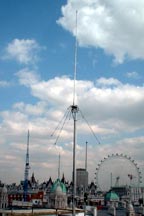 This is easier at VHF and UHF frequencies than it is at frequencies below 30 MHz, as the line-of-sight nature of propagation at these higher frequencies simplifies the tracking operation. At frequencies below about 30 MHz, the accuracy of most of the equipment begins to fall and large, fixed stations are needed to produce any level of detail. Such stations do exist though, and given the fact that MF and HF signals travel large distances, a few of these fixed monitoring stations in two or three neighbouring countries can work together to identify the location of an illegal transmitter (which the mobile teams can then home in on).
This is easier at VHF and UHF frequencies than it is at frequencies below 30 MHz, as the line-of-sight nature of propagation at these higher frequencies simplifies the tracking operation. At frequencies below about 30 MHz, the accuracy of most of the equipment begins to fall and large, fixed stations are needed to produce any level of detail. Such stations do exist though, and given the fact that MF and HF signals travel large distances, a few of these fixed monitoring stations in two or three neighbouring countries can work together to identify the location of an illegal transmitter (which the mobile teams can then home in on).It amazes me, therefore, that there are so many pirate radio stations who continue to operate 24 hours per day, 7 days per week. A quick tune across the FM dial in London at lunchtime in the middle of the week yielded the following stations happily pumping out pumping tunes:
87.9 Shine 879
91.8 Passion FM
93.8 Vibes FM
95.4 Roots FM
97.9 Bassline FM
101.2 Unique
101.9 The Beat
Now it's fair to say that many of these stations are regularly closed down by the authorities, but have sufficient funding and expertise to be back on the air in short shrift. They also tend to use a complicated set of links to connect the studio to the transmitter site such that if the transmitter site is identified, the studio location (where the more expensive equipment and the presenter are located) remains secret. A studio hit on a pirate costs much more to recover from and often leads to prosecution.
It's also fair to say that these staitons have, on the whole, managed to settle on frequencies that tend to minimise the amount of interference they cause to the legal stations. Many pirate stations in London operate only 200 kHz away from legal stations which is far too close to prevent interference (the reasons for which are something to talk about on another day perhaps), but all these stations sit sufficiently far enough away from legal stations (typically a minimum of 400 kHz) that the interference they cause is relatively small. The fact that they are all in mono also improves the situation (and has the bonus for the pirate station that their coverage area is increased). Nonetheless, these stations do cause interference, especially close to the transmitters concerned where the sheer power of the illegal signal overwhealms nearby receivers and the authorities tend to act more virulently where a complaint of interference has been received.
However these aren't the only long-term illegal transmissions that can be found. A recent scan of the short-wave broadcast bands brought to my attention 'Laser Hot Hits' - a pirate station that broadcasts 24/7 on a number of short-wave frequencies (try 4025, 6219, 6285, 7460 and 9385 kHz, though the 7460 kHz signal is often wiped out by a strong BBC DRM transmission from Kvitsoy in Norway on 7465 kHz in the afternoons). What makes this more intriguing than the London pirate situation is that many of the frequencies they are using will cause significant interference not, in this case, to other broadcasters, but to maritime, aeronautical and defence spectrum users, yet their transmissions have remained on-air, seemingly unchecked for many months now. In particular, the 6219 kHz transmission will directly interfere with safety-of-life, emergency maritime communications on 6215 kHz.
So how come they are still on-air? One possibility is that their transmitter site location (not needing to be near to the listeners due to the propagation at HF) is somewhere so remote that the authorities either can't, or can't be bothered, to get to it. A persistant pirate of the late 1980's, 'Radio Fax' used to transmit from a rural location in Ireland and the Irish authorities who have always been much more tolerant to pirate transmissions than many other countries, were very sluggish to step into action. Maybe Laser Hot Hits' transmitter site is on one of the mountains of the Netherlands, which the local mountain rescue teams can't reach! Wherever it is (or they are - there is no reason to suspect that all the frequencies are transmitted from the same site) they have obviously escaped scrutiny so far.
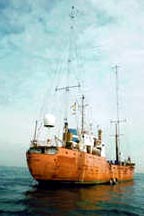 So what conclusions can we draw from this? Perhaps those in power accept 'pirate radio' as a problem that will never go away and for stations who act responsibly turn a blind-eye (remember that pirate radio has had a greater impact on the shape of the UK radio industry than possibly any other factor, and even has a major impact today). Perhaps they do not have the resources to track down every station and concentrate on those who cause the biggest sores (e.g. those with outspoken political views or whose transmitting equipment is of low quality and is causing lots of interference). Perhaps they wait for compliants to be raised before tackling the problem. Whatever the reason, one must doff one's cap to those who continue to flout the law for our entertainment. Many are outlets for music which ordinary stations turn their back on but which has a large, cult, following. Some are there just for the fun of it (don't tell me that doing something naughty isn't at least a little bit thrilling...?) Gentlemen (and ladies), I raise my glass to you.
So what conclusions can we draw from this? Perhaps those in power accept 'pirate radio' as a problem that will never go away and for stations who act responsibly turn a blind-eye (remember that pirate radio has had a greater impact on the shape of the UK radio industry than possibly any other factor, and even has a major impact today). Perhaps they do not have the resources to track down every station and concentrate on those who cause the biggest sores (e.g. those with outspoken political views or whose transmitting equipment is of low quality and is causing lots of interference). Perhaps they wait for compliants to be raised before tackling the problem. Whatever the reason, one must doff one's cap to those who continue to flout the law for our entertainment. Many are outlets for music which ordinary stations turn their back on but which has a large, cult, following. Some are there just for the fun of it (don't tell me that doing something naughty isn't at least a little bit thrilling...?) Gentlemen (and ladies), I raise my glass to you.
